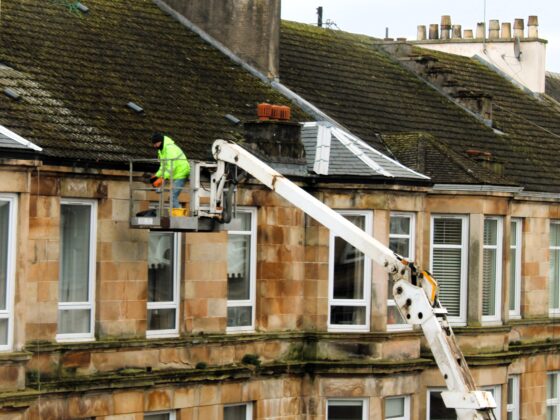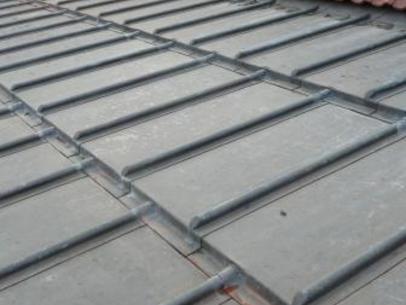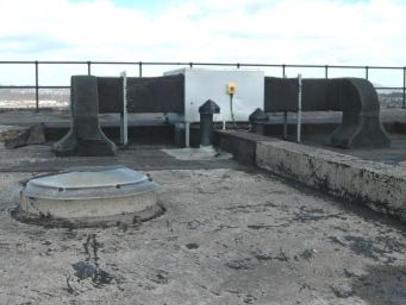It’s critical to keep the roof, gutters, and chimneys of your roof property or block of flats in good repair, but it’s also one of the most difficult parts of your building to inspect. Can new technologies help?
The simplest and cheapest way to check your roof is by visual inspection, either from inside the loft or from a high point nearby, such as a neighbour’s window. However, if that’s not possible, what else can you do?
Drone inspections
 Roof inspections using drones. Close up images can also be obtained. Image courtesy of Balmore Group.
Roof inspections using drones. Close up images can also be obtained. Image courtesy of Balmore Group.
The use of drones is highly regulated in built-up areas, so you need to commission a survey from a company that has CAA registration.
Where can drones operate?
Drone operators need to ensure that they do not go within 50m of a building and keep at least 150m away from built-up areas. When a drone is operated, the person in control of the drone must be able to control people moving around the operational area, so this may mean that street closure is required (and this needs permission from the council). The operator must also maintain visual contact with the drone.
A minimum 30m exclusion zone is required for take off and landing. The operator must carry out a risk assessment before starting.
These standards can be reduced if the drone used has ‘multiple redundancies’, which means it has 8 engines, 4 of which are ‘spare’, a duel battery system, and a triple CPU back up control computer. Such drones can be used with only a 5m exclusion zone for take off and landing, so could take off from a back court area. Contractors with this type of drone will have an ‘enhanced permissions’ issued from the CAA.
Due to the large cost of these aircraft, there are only a select few approved contractors across the UK.
What can a drone inspection achieve?
The best drone inspection will use both a radiometric thermal imaging and visual HD camera.
The thermal imaging camera will identify cold/hot spots caused by leaks etc. This can then be married up with the normal visual image to identify the required repair.
Ask if the firm you intend to use can produce a report that meets National Federation of Roofing Contractor (NFRC) Standards.
An inspection carried out at night time can be used for energy ratings assessments.
 Thermal image showing chimney defects. Note also the temperature changes around the down pipe, indicating a problem. Image courtesy of Balmore Group.
Thermal image showing chimney defects. Note also the temperature changes around the down pipe, indicating a problem. Image courtesy of Balmore Group.
What do drone surveys cost?
You can expect a survey and report to cost about £450 +VAT.
How do I find a suitable drone operator?
A search online for ‘drone roof survey Scotland’ will produce a listing for a number of firms. You can check if this firm is registered by searching on ARPAS-UK Register (ARPAS is the Association of Remotely Piloted Aircraft Systems). You can also cross check that the firm is CAA registered.
Pole and mast photography
Some companies use cameras mounted on telescopic masts or poles. The longest are vehicle mounted and can reach up to 25m. Shorter, hand-held poles can be used to raise a camera to 3-6m in height. Vehicle mounted masts may still require road-closure orders, but can be used where it is not possible to fly a drone.
Costs
Expect to pay about £500 per day, correspondingly, less for a half day.
Finding a mast photographer
Search online for elevated mast or telescopic mast photography.
 Telescopic camera mast in use for roof inspection. Like all roof access methods, savings can be made by working with neighbours.
Telescopic camera mast in use for roof inspection. Like all roof access methods, savings can be made by working with neighbours.
Rope access (steeplejacks)
If you know you have a problem and need to get workers on the roof, then rope access can be considered over using an expensive scaffold.
 Rope access technicians. Sometimes known as ‘steeplejacks’. Image courtesy of Balmore Group.
Rope access technicians. Sometimes known as ‘steeplejacks’. Image courtesy of Balmore Group.
Do I need roof anchors to use rope access workers?
Some buildings have roof anchors installed. The first task for a roof worker will be to use a ‘deadweight’ as a safety measure while they check the roof anchors. However, roof anchors are not always required, and rope access workers may be able to access the roof through a skylight and then rig an abseiling point themselves.
What can rope access workers do?
Roofers using rope access can carry out inspections, minor/major repairs, and gutter cleans.
What would rope access cost?
A typical cost would be around £750 +VAT per day. One day would generally be sufficient to clean gutters, carry out a roof inspection, and some minor repairs on a typical tenement roof. This provides for a team of three, two on the roof and one on the ground. This does not include the cost of any materials required for repairs.
If the workers also need to erect a small 10m alloy scaffold tower, this will add perhaps another £100 +VAT. Road closure permits are not normally required.
How do I find a rope access firm?
Search online for ‘rope access roofs’. Check that the firm you are proposing to use is a member of registered trade body, such as the National Federation of Roofing Contractors, or Association of Technical Lightning and Access Specialists.
 Rope access surveys. Rope access can also be used to inspect walls. Image courtesy of Balmore Group.
Rope access surveys. Rope access can also be used to inspect walls. Image courtesy of Balmore Group.
Tower access
When do we need tower access?
Roofing contractors can use a number of alloy towers, many of which are narrow enough to fit through a close, so that the rear slope of a roof can be accessed. These allow workers to undertake gutter cleaning and minor roof repairs. Tower access can also allow workers to check walls, downpipes etc.
What does tower access cost?
Depending on size, the cost is slightly less than using a rope access technician, but a permit costing between £100 and £250 may be required if the tower needs to a sited on a busy pavement which needs to be closed off.
Powered access
When do we need powered access?
Cherry pickers are useful where several front gutters need to be cleaned in one day and rope access is not feasible. They are also suitable for providing access for tradespeople who are not trained to work at height, such as surveyors and architects, painters, and stonemasons.
A major problem with cherry pickers is that they cannot be used to access the rear slope of the roof, so can only be used for half a job in a typical tenement gutter clean and roof check job.
What do cherry pickers cost?
Cherry pickers are perhaps the most expensive means of access and generally have an additional costs for a street closure permit (£100- £250 plus time to obtain permit from the council). Hire and labour costs can take the cost of using a cherry picker to £800-£900 per day +VAT. The cost can be considerably more if your building is much higher, or if you need a machine that can reach over the roof to allow access to the rear slope
Vacuum gutter cleaning systems
These systems use a high-powered industrial vacuum machine connected to a set of carbon fibre poles. The machine sucks materials from the gutter. A camera can be attached to the pole end, so the operator can see what is happening.
When can we use a vacuum gutter cleaning system?
These systems are used only for cleaning gutters, so won’t be suitable if you suspect that you need roof repairs or a roof inspection. The main limitation of the use of these systems is height – they have a maximum reach of 12m, which would deal with a three- to four-storey tenement. They can be used to access rear gutters.
What do vacuum cleaning systems cost?
The cost of this equipment can vary depending on your type of building as costs are often given per linear metre of gutter.
How we find vacuum gutter cleaning firms?
Search online for a firm near you. There is no recognised trade body that firms who specialise in this work can join, so you must check for yourself that the firm has adequate insurance and a suitable health and safety policy.




